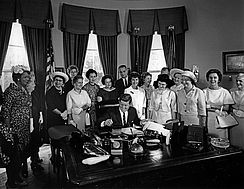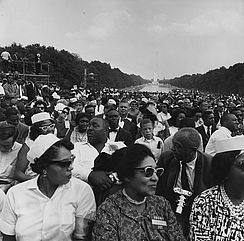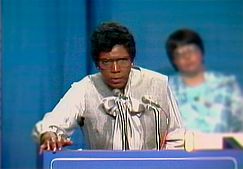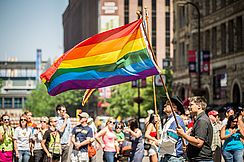Workplace & Family
Changing American Families
What was Beth Robinson’s argument before the Vermont Supreme Court that proved to be a powerful salvo for winning marriage equality?
Excerpt from “The State of Marriage,” a film by Jeff Kaufman. (Running time 4:15) Used with permission. The complete film is available from Floating World Pictures.
If there ever was such a thing as a typical American family, it’s long gone. The male breadwinner/female homemaker image of family has been supplanted by a complex portrait. Today’s families reflect new social, cultural, and demographic realities as well as increasing diversity and widening economic disparity. A look at American families today reveals a growing number of single female heads of household, stay-at-home dads, same-sex parents, blended families, and single people who define themselves as a family of one. This diversity of family and lifestyle options adds up to a major shift in traditional norms that govern households and families. In 2013, Natalie Angier observed: “Researchers who study the structure and evolution of the American family express unsullied astonishment at how rapidly the family has changed in recent years, transformations often exceeding or capsizing those same experts’ predictions.”
Marriage has undergone significant changes, and its position as the dominant social institution is in transition. Let’s look at some basic numbers and how they have changed over time. Barely half of all adults in the U.S. are currently married, and 30 percent have never been married. In 1960, the average age of first marriage was 22 for men and 20 for women, but it has been rising steadily ever since: 26 for men and 23 for women in 1990, and now 29 and 27. The divorce rate increased dramatically in the 1970s and 1980s, to 50 percent, then leveled off; it is now 40 percent for first-time marriages. But many divorced people remarry, often multiple times, resulting in a range of blended families of his, hers, and ours. Other people are quite content to live in committed relationships without marriage. A new factor, not yet fully reflected in statistics, is the growing number of gay marriages, although marriage still applies to a minority of same-sex couples. All these indicators point to an institution in flux.
Another change for American families is the falling birthrate, a significant long-term trend only briefly interrupted by the baby boom of the 1950s. In 2011, the total fertility rate was 1.89 per woman, well below the 2.1 replacement rate. The number of women in their early twenties having children has fallen to a record low, whereas the proportion of women in their late thirties and early forties having children is rising, thanks in part to breakthroughs in reproductive technologies like in vitro fertilization.

And adoption continues to be an important option for many women, and men, who want to raise a child. International adoptions, which numbered almost 250,000 between 1999 and 2012, place children mainly from China, Russia, and South Korea; they have helped make American families even more diverse.
The biggest change over the past fifty years is the growing number of women who are not married at the time they give birth. The United States has one of the highest rates of teenage pregnancy in the world, but those rates have been declining for two decades. This upswing in births by unmarried women represents far more than unlucky teenagers lacking access to reliable birth control. The United States is reaching a point at which having children is no longer inextricably bound with marriage, although the consequences are dramatically different depending on class and race.
At the upper end of the economic spectrum, women are embracing new patterns of family life. The best example is the number of never-married professional women who decide to become mothers, even when a suitable partner does not seem to be in the cards. Usually this decision occurs when the woman is somewhat older, more established in her career, and able to afford this step. Another example is lesbian couples, who pioneered an array of new approaches to parenthood by becoming mothers long before gay marriage was legalized in many states.
The experience of single motherhood is vastly different at the other end of the economic spectrum. The most direct consequence of the growth of single women who are the sole support for their families — a category that includes single, widowed, divorced, and deserted women — is a dramatic rise in childhood poverty. The number of children living in poverty is directly linked to women’s low wages. Households headed by single mothers are five times as likely to be below the poverty line as two-parent families. The United States ranks a shocking first in terms of child poverty in the developed world. The struggle of single mothers hovering near the poverty level was made more difficult by the passage of the Personal Responsibility and Work Opportunity Reconciliation Act of 1996 (PRWORA), fulfilling President Bill Clinton’s pledge “to end welfare as we know it.”

Starting in the 1960s, the number of female-headed households receiving welfare, mainly payments from the Aid to Families with Dependent Children (AFDC) program, surged; by 1994, 14 million Americans were receiving AFDC support. These payments were far from generous, but many conservatives believed that women, especially single black women, were having children in order to qualify for AFDC payments. Welfare activist Johnnie Tillmon punctured that argument: “Having babies for profit is a lie that only men could make up, and only men could believe.” The PRWORA, which limited women and children to no more than five years of federal assistance, cut the welfare rolls in half by 2000 and forced many poor women to take any job available, no matter how low the pay and how few the benefits.
Even many two-parent households have difficulty staying above the poverty level. In families with both a male and a female wage earner, women contribute about 42 percent of overall family income, up from 30 percent several decades ago. And women still shoulder a larger share of responsibilities for household management, childcare, and elder care: twenty-eight hours a week to men’s sixteen. In many ways, however, the fact that men are contributing sixteen hours a week to what used to be considered women’s sole responsibility is a dramatic change, reflecting a definite loosening of traditional gender norms.
An excellent example of these changing gender roles is the stay-at-home dad who serves as the primary caregiver for his family’s children. This new role represents the congruence of several larger trends: a rise in women’s income and career prospects; a desire by many men to play a more active role in their children’s upbringing; the ability to telecommute or work flexible hours from home; and a need to find a family-friendly alternative to expensive daycare. While some men found themselves drafted into this new role when unemployed during a period of economic disruption, such as the 2008–2009 recession, most made the choice affirmatively. A downside for men can be similar to those of some full-time housewives — isolation and loneliness. And many wives also have to make a significant adjustment, relinquishing the idea that they are the primary authority in charge of the children and the household routines.
This diversity of family and lifestyle options amounts to a major shift in the norms that have traditionally governed households and families. For some women, these changes represent expanding opportunities and provide them with the ability to make positive choices about how to structure their work and personal lives. But for other women, especially single women who are the head of the household and engaged in a daily struggle to get by, the limitations of these changes are a reminder that class and race, not just gender, are important to understanding women’s work and family lives.
How to Navigate our Interactive Timeline
You will find unique content in each chapter’s timeline.
Place the cursor over the timeline to scroll up and down within the timeline itself. If you place the cursor anywhere else on the page, you can scroll up and down in the whole page – but the timeline won’t scroll.
To see what’s in the timeline beyond the top or bottom of the window, use the white “dragger” located on the right edge of the timeline. (It looks like a small white disk with an up-arrow and a down-arrow attached to it.) If you click on the dragger, you can move the whole timeline up or down, so you can see more of it. If the dragger won’t move any further, then you’ve reached one end of the timeline.
Click on one of the timeline entries and it will display a short description of the subject. It may also include an image, a video, or a link to more information within our website or on another website.
Our timelines are also available in our Resource Library in non-interactive format.
Timeline Legend
Yellow bars mark entries that appear in every chapter
This icon indicates a book
This icon indicates a film
1971 The Click! Moment
The idea of the “Click! moment” was coined by Jane O’Reilly. “The women in the group looked at her, looked at each other, and ... click! A moment of truth. The shock of recognition. Instant sisterhood... Those clicks are coming faster and faster. They were nearly audible last summer, which was a very angry summer for American women. Not redneck-angry from screaming because we are so frustrated and unfulfilled-angry, but clicking-things-into-place-angry, because we have suddenly and shockingly perceived the basic disorder in what has been believed to be the natural order of things.” Article, “The Housewife's Moment of Truth,” published in the first issue of Ms. Magazine and in New York Magazine. Republished in The Girl I Left Behind, by Jane O'Reilly (Macmillan, 1980). Jane O'Reilly papers, Schlesinger Library.































































